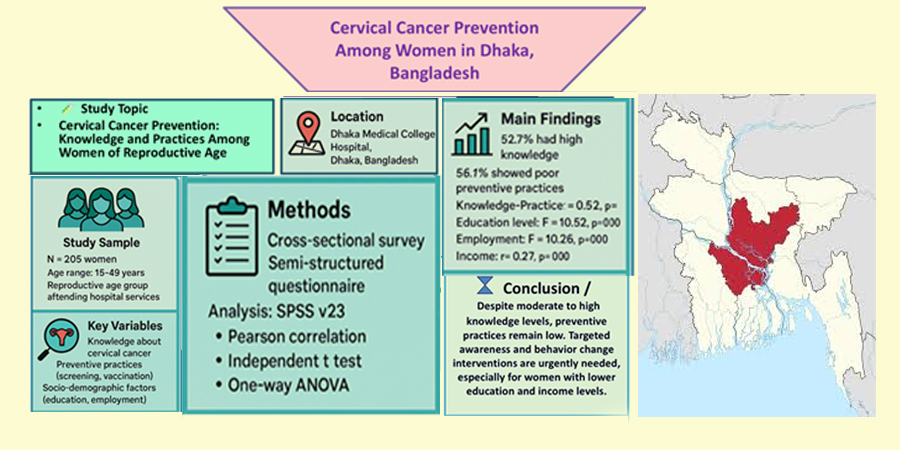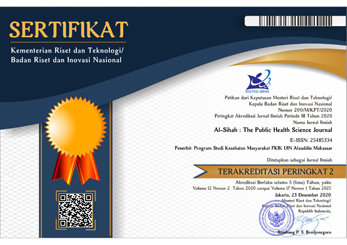Cervical Cancer Prevention Knowledge and Practices Among Reproductive-Age Women
A Cross-Sectional Study at a Tertiary Hospital in Dhaka
DOI:
https://doi.org/10.24252/al-sihah.v17i1.56092Keywords:
cervical cancer, female, human papillomavirus, knowledge, uterine cervical neoplasmsAbstract
While cervical cancer is both preventable and curable if detected early, knowledge and preventive practices among reproductive-age women in Bangladesh remain largely underexplored, particularly in urban settings. This study aims to address this gap through an assessment of cervical cancer prevention knowledge and practices among female patients at a tertiary hospital in Dhaka. A cross-sectional survey was conducted at Dhaka Medical College Hospital over a one-month period, with data collected from 205 women using a semi-structured questionnaire. SPSS version 23 was utilized for data analysis, including Pearson correlation, two-sample t-test, and one-way ANOVA. The results showed that 52.7 percent of participants had high knowledge of cervical cancer prevention, while 56.1 percent exhibited poor preventive practices. A significant correlation (r = 0.52, p < 0.001) was found between knowledge and practice. Additionally, factors like level of secondary education (F = 10.52, p < 0.001), employment status (F = 10.26, p < 0.001), and monthly income (r = 0.27, p < 0.001) were significantly associated with knowledge. The findings indicate that, despite high levels of knowledge, preventive practices remain poor, highlighting the need for enhanced awareness initiatives and behavior change interventions aimed at improving cervical cancer prevention. This disconnect between awareness and practice underscores the importance of designing culturally sensitive and accessible behavior change interventions, particularly targeting populations with lower educational attainment and those who are unemployed, to translate knowledge into sustained preventive practices.
Downloads
References
Alam, N., Islam, M., Rayyan, F., Ifa, H., Khabir, M., Chowdhury, K., & Mohiuddin, A. (2022). Lack of knowledge is the leading key for the growing cervical cancer incidents in bangladesh: a population based, cross-sectional study. Plos Global Public Health, 2(1), e0000149. https://doi.org/10.1371/journal.pgph.0000149
Arrivillaga, M., Bermúdez, P. C., García-Cifuentes, J. P., Rodríguez-López, M., Neira, D., & Vargas-Cardona, H. D. (2023). Women's critical experiences with the pap smear for the development of cervical cancer screening devices. Heliyon, 9(3). https://doi.org/10.1016/j.heliyon.2023.e14289
Assoumou, S.Z., Mabika, B.M., Mbiguino, A.N. et al. Awareness and knowledge regarding of cervical cancer, Pap smear screening and human papillomavirus infection in Gabonese women. BMC Women's Health 15, 37 (2015). https://doi.org/10.1186/s12905-015-0193-2
Aweke, Y. H., Ayanto, S. Y., & Ersado, T. L. (2017). Knowledge, attitude and practice for cervical cancer prevention and control among women of childbearing age in Hossana Town, Hadiya zone, Southern Ethiopia: Community-based cross-sectional study. PLOS ONE, 12(7), e0181415. https://doi.org/10.1371/journal.pone.0181415
Banik, S., Sahu, D. P., & Bhattacharjya, H. (2022). Knowledge and practice regarding cervical cancer prevention among women in a rural area of Tripura, India. International Journal of Community Medicine and Public Health, 9(2), 763–768. https://doi.org/10.18203/2394-6040.ijcmph20220230
Baral, S. K., Biswas, P., Kaium, M. A., Islam, M. A., Dey, D., Saber, M. A., & Kim, B. (2022). A comprehensive discussion in vaginal cancer based on mechanisms, treatments, risk factors and prevention. Frontiers in Oncology, 12, 883805. https://doi.org/10.3389/fonc.2022.883805
Chowdhury, S. H., Banu, B., Akter, N., & Hossain, S. M. (2022). Unmet supportive care needs and predictor of breast cancer patients in Bangladesh: A cross-sectional study. Journal of Oncology Pharmacy Practice, 28(8), 1687-1695. https://doi.org/10.1177/10781552211039114
Deeba, I. and Hossain, M. (2023). Cervical cancer screening and prevention in low- and middle-income countries: a perspective from bangladesh. Bangladesh Journal of Microbiology, 39(2), 76-82. https://doi.org/10.3329/bjm.v39i2.66268
Directorate General of Health Services. (2017). National strategy for cervical cancer prevention and control, Bangladesh 2017–2022. Ministry of Health and Family Welfare, Bangladesh.
Directorate General of Health Services. (2017). National strategy for cervical cancer prevention and control, Bangladesh (2017–2022). Health Services Division, Ministry of Health and Family Welfare, Government of the People's Republic of Bangladesh.
Hoque, M., Nahar, N., Mahbub, M., Akter, J., & Ara, B. (2023). Factors related to delay in cervical cancer diagnosis and treatment among women in bangladesh: a cross-sectional study. Journal of Biomedical Sciences, 10(1), 3-10. https://doi.org/10.3126/jbs.v10i1.56076
Islam, R. M., Billah, M., Hossain, M. N., & Oldroyd, J. (2018). Barriers to cervical cancer screening among Bangladeshi women: A literature review. South Asian Journal of Cancer, 7(1), 27–30. https://doi.org/10.4103/sajc.sajc_14_17
Islam, T. (2025). Awareness about cervical cancer and its socio-economic determinants among adults in bangladesh: results from a nationwide cross-sectional study. Plos One, 20(6), e0325712. https://doi.org/10.1371/journal.pone.0325712
Kadian, L., Gulshan, G., Sharma, S., Kumari, I., Yadav, C., Nanda, S., & Yadav, R. (2021). A study on knowledge and awareness of cervical cancer among females of rural and urban areas of Haryana, North India. Journal of Cancer Education, 36(4), 844–849. https://doi.org/10.1007/s13187-020-01791-3
Kakotkin, V. V., Semina, E. V., Zadorkina, T. G., & Agapov, M. A. (2023). Prevention strategies and early diagnosis of cervical cancer: current state and prospects. Diagnostics, 13(4), 610. https://doi.org/10.3390/diagnostics13040610
Makura, T. G., Mafirakureva, N., Kadzatsa, W., Mugurungi, O., Kufa-Chakezha, T., & Nyabeze, W. (2015). Awareness and uptake of cervical cancer screening among women in Zimbabwe: A cross-sectional study. BMC Public Health, 15, 1060. https://doi.org/10.1186/s12889-015-2403-4
Mustari, S., Hossain, B., Diah, N. M., & Kar, S. (2019). Opinions of urban women on Pap test: Evidence from Bangladesh. Asian Pacific Journal of Cancer Prevention: APJCP, 20(6), 1613–1618. https://doi.org/10.31557/APJCP.2019.20.6.1613
Nasrin, S., & Rahman, K. F. (2021). Child marriage in Bangladesh: A situation analysis. International Journal of Research and Innovation in Social Science, 5(1), 111–117.
National Institute of Population Research and Training (NIPORT), ICF, & Mitra and Associates. (2020). Bangladesh Demographic and Health Survey 2017–18. NIPORT and ICF.
Nelson, S. B., Viswanathan, N., Jenifer, N. A., & Piranha, B. (2018). A cross-sectional study on cervical cancer and its prevention among women of age group 25–50 years in a rural area of South Tamil Nadu, India. International Journal of Community Medicine and Public Health, 5(6), 2536–2541. https://doi.org/10.18203/2394-6040.ijcmph20182191
Oyediran, K. A., Makinde, O. A., & Adelakin, M. (2021). Cervical cancer knowledge and screening uptake among women of reproductive age in Lagos, Nigeria: A cross-sectional study. BMC Women's Health, 21, 176. https://doi.org/10.1186/s12905-021-01323-1
Papri, F. S., Khanam, Z., Islam, F., & Hakim, M. M. (2015). Knowledge and awareness about risk factors of cervical cancer, its screening, and vaccination among women attending Chittagong Medical College Hospital. Chattagram Maa-O-Shishu Hospital Medical College Journal, 14(2), 57–60.
Qayum, M., Jannat, M., & Akter, S. (2021). Knowledge and awareness about cervical cancer among women in Bangladesh. Asian Pacific Journal of Cancer Prevention, 22(2), 497–503. https://doi.org/10.31557/APJCP.2021.22.2.497
Rahman, M., Sharif, A., U, B., Bari, S., Khan, S., Jerin, I., & Orthi, S. (2025). Knowledge, attitude and practice related to cervical cancer prevention among medical students in bangladesh: a cross-sectional study.. https://doi.org/10.21203/rs.3.rs-6164354/v1
Rakhshanda, S., Dalal, K., Chowdhury, H., Mayaboti, C., Paromita, P., Rahman, A., & Mashreky, S. (2021). Assessing service availability and readiness to manage cervical cancer in bangladesh. BMC Cancer, 21(1). https://doi.org/10.1186/s12885-021-08387-2
Reza, S., Dewan, S., Islam, M., & Shahriar, M. (2024). Response of bangladesh to the world health organization call to eliminate cervical cancer as a public health issue: an observational report. Health Science Reports, 7(6). https://doi.org/10.1002/hsr2.2178
Saeed, S., Asim, M., & Sohail, M. M. (2021). Fears and barriers: problems in breast cancer diagnosis and treatment in Pakistan. BMC women's health, 21, 1-10. https://doi.org/10.1186/s12905-021-01293-6
Satapathy, P., Khatib, M. N., Neyazi, A., Qanawezi, L., Said, S., Gaidhane, S., & Rabaan, A. A. (2024). Prevalence of human papilloma virus among cervical cancer patients in India: A systematic review and meta-analysis. Medicine, 103(31), e38827. https://doi.org/10.1097/md.0000000000038827
Singh, D., Vignat, J., Lorenzoni, V., Eslahi, M., Ginsburg, O., Lauby-Secretan, B., & Vaccarella, S. (2023). Global estimates of incidence and mortality of cervical cancer in 2020: a baseline analysis of the WHO Global Cervical Cancer Elimination Initiative. The lancet global health, 11(2), e197-e206. https://doi.org/10.1016/s2214-109x(22)00501-0
Taneja, N., Chawla, B., Awasthi, A. A., Shrivastav, K. D., Jaggi, V. K., & Janardhanan, R. (2021). Knowledge, attitude, and practice on cervical cancer and screening among women in India: a review. Cancer Control, 28, 10732748211010799. https://doi.org/10.1177/10732748211010799
UNICEF. (2020). Ending child marriage: A profile of progress in Bangladesh. United Nations Children’s Fund. https://www.unicef.org/bangladesh/en/reports/ending-child-marriage
World Health Organization. (2020). Global strategy to accelerate the elimination of cervical cancer as a public health problem. https://www.who.int/publications/i/item/9789240014107
World Health Organization. (2021). Cervical cancer: An NCD we can overcome. https://www.who.int/news-room/fact-sheets/detail/cervical-cancer

Downloads
Published
How to Cite
Issue
Section
License
Copyright (c) 2025 Fatema Khatun, Ismail Hosen, Laila Sharmin Lipi, Pilot Hossen, Fardina Rahman Omi

This work is licensed under a Creative Commons Attribution-NonCommercial-ShareAlike 4.0 International License.
Authors retain copyright and grant the journal right of first publication with the work simultaneously licensed under a Creative Commons Attribution-NonCommercial-ShareAlike 4.0 International License that allows others to share the work with an acknowledgment of the work's authorship and initial publication in this journal.
Authors are able to enter into separate, additional contractual arrangements for the non-exclusive distribution of the journal's published version of the work (e.g., post it to an institutional repository or publish it in a book), with an acknowledgment of its initial publication in this journal.
Authors are permitted to publish their work online in third parties as it can lead to wider dissemination of the work.













